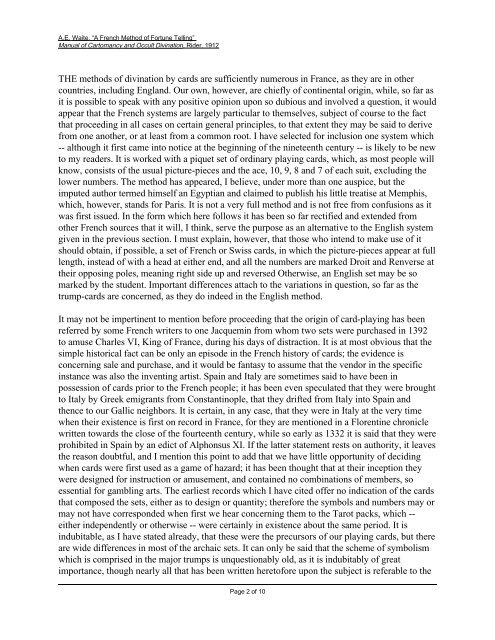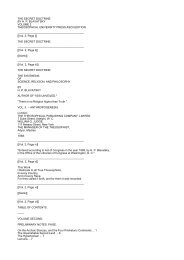A French Method of Fortune Telling by Playing Cards
A French Method of Fortune Telling by Playing Cards
A French Method of Fortune Telling by Playing Cards
Create successful ePaper yourself
Turn your PDF publications into a flip-book with our unique Google optimized e-Paper software.
A.E. Waite, “A <strong>French</strong> <strong>Method</strong> <strong>of</strong> <strong>Fortune</strong> <strong>Telling</strong>”<br />
Manual <strong>of</strong> Cartomancy and Occult Divination, Rider, 1912<br />
THE methods <strong>of</strong> divination <strong>by</strong> cards are sufficiently numerous in France, as they are in other<br />
countries, including England. Our own, however, are chiefly <strong>of</strong> continental origin, while, so far as<br />
it is possible to speak with any positive opinion upon so dubious and involved a question, it would<br />
appear that the <strong>French</strong> systems are largely particular to themselves, subject <strong>of</strong> course to the fact<br />
that proceeding in all cases on certain general principles, to that extent they may be said to derive<br />
from one another, or at least from a common root. I have selected for inclusion one system which<br />
-- although it first came into notice at the beginning <strong>of</strong> the nineteenth century -- is likely to be new<br />
to my readers. It is worked with a piquet set <strong>of</strong> ordinary playing cards, which, as most people will<br />
know, consists <strong>of</strong> the usual picture-pieces and the ace, 10, 9, 8 and 7 <strong>of</strong> each suit, excluding the<br />
lower numbers. The method has appeared, I believe, under more than one auspice, but the<br />
imputed author termed himself an Egyptian and claimed to publish his little treatise at Memphis,<br />
which, however, stands for Paris. It is not a very full method and is not free from confusions as it<br />
was first issued. In the form which here follows it has been so far rectified and extended from<br />
other <strong>French</strong> sources that it will, I think, serve the purpose as an alternative to the English system<br />
given in the previous section. I must explain, however, that those who intend to make use <strong>of</strong> it<br />
should obtain, if possible, a set <strong>of</strong> <strong>French</strong> or Swiss cards, in which the picture-pieces appear at full<br />
length, instead <strong>of</strong> with a head at either end, and all the numbers are marked Droit and Renverse at<br />
their opposing poles, meaning right side up and reversed Otherwise, an English set may be so<br />
marked <strong>by</strong> the student. Important differences attach to the variations in question, so far as the<br />
trump-cards are concerned, as they do indeed in the English method.<br />
It may not be impertinent to mention before proceeding that the origin <strong>of</strong> card-playing has been<br />
referred <strong>by</strong> some <strong>French</strong> writers to one Jacquemin from whom two sets were purchased in 1392<br />
to amuse Charles VI, King <strong>of</strong> France, during his days <strong>of</strong> distraction. It is at most obvious that the<br />
simple historical fact can be only an episode in the <strong>French</strong> history <strong>of</strong> cards; the evidence is<br />
concerning sale and purchase, and it would be fantasy to assume that the vendor in the specific<br />
instance was also the inventing artist. Spain and Italy are sometimes said to have been in<br />
possession <strong>of</strong> cards prior to the <strong>French</strong> people; it has been even speculated that they were brought<br />
to Italy <strong>by</strong> Greek emigrants from Constantinople, that they drifted from Italy into Spain and<br />
thence to our Gallic neighbors. It is certain, in any case, that they were in Italy at the very time<br />
when their existence is first on record in France, for they are mentioned in a Florentine chronicle<br />
written towards the close <strong>of</strong> the fourteenth century, while so early as 1332 it is said that they were<br />
prohibited in Spain <strong>by</strong> an edict <strong>of</strong> Alphonsus XI. If the latter statement rests on authority, it leaves<br />
the reason doubtful, and I mention this point to add that we have little opportunity <strong>of</strong> deciding<br />
when cards were first used as a game <strong>of</strong> hazard; it has been thought that at their inception they<br />
were designed for instruction or amusement, and contained no combinations <strong>of</strong> members, so<br />
essential for gambling arts. The earliest records which I have cited <strong>of</strong>fer no indication <strong>of</strong> the cards<br />
that composed the sets, either as to design or quantity; therefore the symbols and numbers may or<br />
may not have corresponded when first we hear concerning them to the Tarot packs, which --<br />
either independently or otherwise -- were certainly in existence about the same period. It is<br />
indubitable, as I have stated already, that these were the precursors <strong>of</strong> our playing cards, but there<br />
are wide differences in most <strong>of</strong> the archaic sets. It can only be said that the scheme <strong>of</strong> symbolism<br />
which is comprised in the major trumps is unquestionably old, as it is indubitably <strong>of</strong> great<br />
importance, though nearly all that has been written heret<strong>of</strong>ore upon the subject is referable to the<br />
Page 2 <strong>of</strong> 10
















